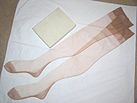
A wetsuit is a garment worn to provide thermal protection while wet. It is usually made of foamed neoprene, and is worn by surfers, divers, windsurfers, canoeists, and others engaged in water sports and other activities in or on water. Its purpose is to provide thermal insulation and protection from abrasion, ultraviolet exposure, and stings from marine organisms. It also contributes extra buoyancy. The insulation properties of neoprene foam depend mainly on bubbles of gas enclosed within the material, which reduce its ability to conduct heat. The bubbles also give the wetsuit a low density, providing buoyancy in water.

A boot is a type of footwear. Most boots mainly cover the foot and the ankle, while some also cover some part of the lower calf. Some boots extend up the leg, sometimes as far as the knee or even the hip. Most boots have a heel that is clearly distinguishable from the rest of the sole, even if the two are made of one piece. Traditionally made of leather or rubber, modern boots are made from a variety of materials.

A blister is a small pocket of body fluid within the upper layers of the skin, usually caused by forceful rubbing (friction), burning, touching poison ivy, freezing, chemical exposure or infection. Most blisters are filled with a clear fluid, either serum or plasma. However, blisters can be filled with blood or with pus.

Leggings are several types of leg attire that have varied through the years. Modern usage from the 1960s onwards has come to refer to elastic close-fitting high-rise garments worn over the legs typically by women, such as leg warmers or tights. Usage from the 18th century refers to men's wear usually made of cloth or leather that is wrapped around the leg down to the ankle. In the 19th century, leggings usually referred to infants' leg clothing that were matched with a jacket, as well as leg-wrappings made of leather or wool and worn by soldiers and trappers. Leggings prominently returned to women's fashion in the 1960s, drawing from the form-fitting clothing of dancers. With the widespread adoption of the synthetic fibre Lycra and the rise in popularity of aerobics, leggings came to further prominence in the 1970s and 1980s, and eventually made their way into streetwear. Leggings are a part of the late 2010s into the 2020s athleisure fashion trend of wearing activewear outside sporting activities and in casual settings.

Mukluks or kamik are soft boots, traditionally made of reindeer (caribou) skin or sealskin, and worn by Arctic aboriginal people, including the Inuit, Iñupiat, and Yup'ik.

Sports equipment, sporting equipment, also called sporting goods, are the tools, materials, apparel, and gear used to compete in a sport and varies depending on the sport. The equipment ranges from balls, nets, and protective gear like helmets. Sporting equipment can be used as protective gear or a tool used to help the athletes play the sport. Over time, sporting equipment has evolved because sports have started to require more protective gear to prevent injuries. Sporting equipment may be found in any department store or specific sporting equipment shops.
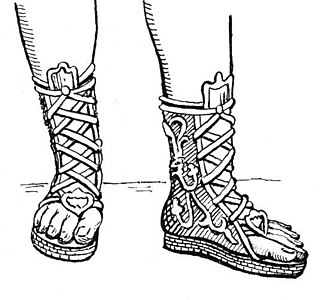
A buskin is a knee- or calf-length boot made of leather or cloth, enclosed by material, and laced, from above the toes to the top of the boot, and open across the toes. A high-heeled version was worn by Athenian tragic actors. It was also worn by hunters, and soldiers in Ancient Greek, Etruscan, and Roman societies, to protect the lower legs against thorns, dirt, etc.
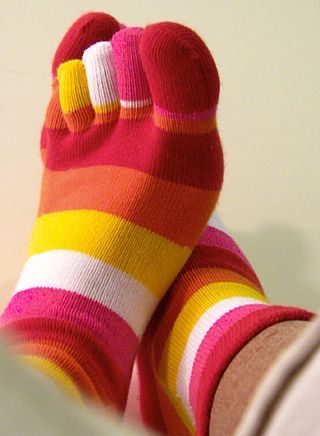
Toe socks are socks that have been knitted so that each toe is individually encased the same way as fingers within a glove.
A layette is a collection of clothing and accessories for a newborn child. The term "layette set" is commonly used in the United States to refer to sets of baby clothes. In the 1920s, expectant mothers or their friends and relatives frequently knitted a matching layette set, consisting of a blanket, hat, sweater and booties. That tradition has continued to the present day.
The Shoe People is an animated television series which was first broadcast in the UK in April 1987 on TV-am. It went on to be broadcast in 62 countries around the world.

Knee highs are hosiery that cover the feet and legs up to the knee. A fashion accessory for casual and classic cool or warm weather apparel. Typically worn by women in many societies, they are sometimes worn with modern semi-formal attire. Unlike ordinary socks, they are generally made of nylon or other stocking materials. There were also different types and uses of knee highs for women.
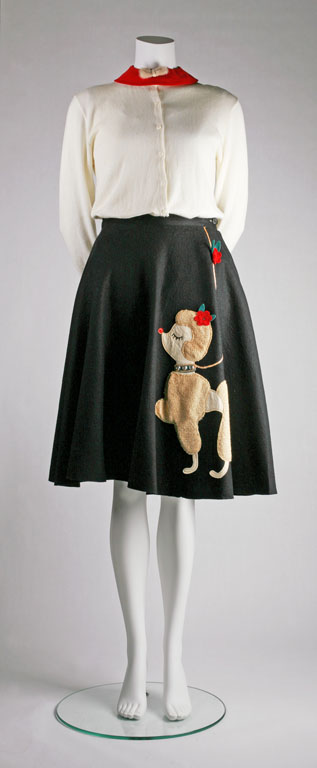
A poodle skirt is a wide swing felt skirt of a solid color displaying a design appliquéd or transferred to the fabric. The design was often a coiffed poodle. Later substitutes for the poodle patch included flamingoes, flowers, and hot rod cars. Hemlines were to the knee or just below it. It quickly became very popular with teenage girls, who wore them at school dances, and as everyday wear.
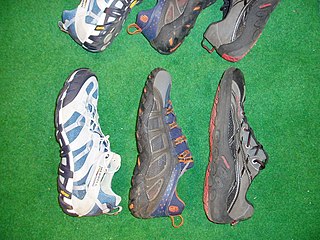
A water shoe is a type of footwear that is typically used for activities where the feet are likely to become wet, such as kayaking. Water shoes are usually made of mesh and have a hard sole used to prevent cuts and abrasions when walking in wet, rocky environments. They may often have tiny holes on the bottom or sides of the sole to allow for quick water drainage, which helps the wearer's feet dry faster, keeps the shoe light, and prolongs the lifespan of the material. Additionally, most people do not wear socks with water shoes.
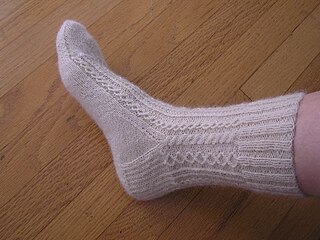
A sock is a piece of clothing worn on the feet and often covering the ankle or some part of the calf. Some types of shoes or boots are typically worn over socks. In ancient times, socks were made from leather or matted animal hair. In the late 16th century, machine-knit socks were first produced. Until the 1800s, both hand-made and machine-knit socks were manufactured, with the latter technique becoming more common in the 19th century, and continuing until the modern day.
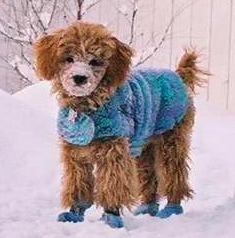
Dog booties, commonly called booties, are rubber, fabric, or plastic coverings for dogs' paws used to protect the animal from cold weather, rough terrain, or injury. They are analogous to human shoes and are most common in sled dog races. Many races require booties as a basic element of dog care. The Yukon Quest Sled Dog Race for example, requires mushers to carry no fewer than eight booties per dog.

Boat shoes are typically canvas or leather with non-marking rubber soles designed for use on a boat. A siping pattern is cut into the soles to provide grip on a wet deck; the leather construction, along with the application of oil, is designed to repel water; and the stitching is highly durable. Boat shoes are traditionally worn without socks.

Smelly socks are socks that have acquired a strong odour due to prolonged wearing. Their odour, which is complex and remains the object of study, is a mixture of ammonia, fatty acids, and lactic acid.

Dog fashion is a popular style or practice, especially in canine clothing and accessories. Dog fashion is a distinctive trend of the style in which people dress their canine companions. This trend dates back to the Egyptian predynastic period and has since expanded due to increased consumer capitalism. Other animals such as cats may also wear fashion.
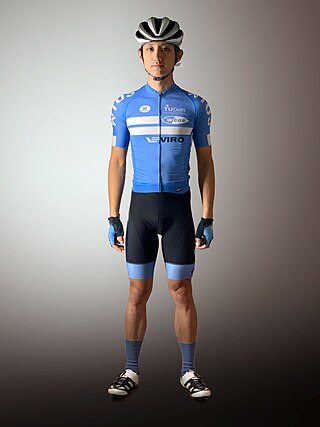
In competitive cycling, the kit is the standard equipment and attire worn specifically by athletes participating in the sport. The outfits differ from the clothes worn in other forms of cycling, such as commuting and recreational cycling. Competitive kit uses technical and performance materials and features to improve efficiency and comfort. The UCI specify the kit and the design the riders use.


















